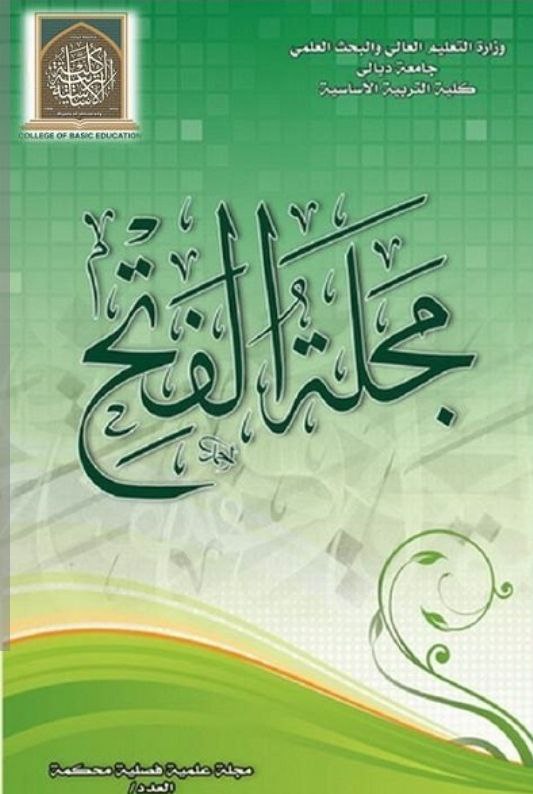Emotional divorce among different social segments in Iraqi society
Abstract
This paper deals with sentimental divorce among various social
classes in the Iraqi society, thus the researchers labored to recognize
the sentimental divorce phenomenon among various classes and
ranks of the Iraqi society via identifying the most apparent negative
sides that lead to sentimental divorce. The researchers set a
questionnaire of (44) items in its final format which is applied on a
sample of married males and females (employed, not employed)
with a total number of (200) persons.
The study aims at:
1. Identifying the level of sentimental divorce within the sample
of the study.
2. Knowing the level of sentimental divorce among different
statuses in the Iraqi society according to gender variable.
3. Recognizing the level of sentimental divorce among various
social ranks in the Iraqi society according to the work variable
(employed, not employed).
4. Identifying the level of sentimental divorce among numerous
social classes in the Iraqi society according to the number of family
members (less than three, four and more).
The researchers concluded that the sentimental divorce phenomenon
is more recurrent among working persons than with jobless persons.
Therefore, the researchers recommend the following:
1.Conducting seminars or cultural debates concerning the
phenomenon of sentimental divorce and its effect on the society.
2.Assisting working persons in solving their administrative and
working problems so as not to negatively influence them and their
families in turn.
The researchers suggest the following:
1.Setting a similar study on other social groups not dealt with in the
present paper.
References
-اثٓ ِٕظٛه , )1979ٌَ )بْ اٌؼوة ث١وٚد ٌٍطجبػخ – ٌجٕبْ .
-ثلٚٞ , اؽّل ىوٟ , )1986ِ )ظطٍؾبد اٌؼٍَٛ االعزّبػ١خ ,ث١وٚد ٌٍٕشو, ٌجٕبْ.
-ؽغبىٞ , ِظطفٝ , )2005 )اٌزقٍف االعزّبػٟ – ث١وٚد ,ث١وٚد ٌٍٕشو,ٌجٕبْ .
-اٌقٌٟٛ , ٍٕبء , )1984 )اٌيٚط ٚاٌؼاللخ االٍو٠خ – كاه اٌّؼوفخ اٌغبِؼ١خ –
ِظو .
-اٌقٌٟٛ , ٍٕبء , )1930 )االٍوح ٚاٌؾ١بح اٌؼبئٍ١خ – ِووي اٌىزت اٌضمبف١خ – اٌمب٘وح
.
-كٍٛلٟ , ِّلٚػ ِؾّل , )2002 )االٍوح ؽل٠ضخ اٌزىٛ٠ – ٓكاه اٌّؼوفخ – اٌمب٘وح
.
-كٍٛلٟ , ػجل اٌَالَ , )1979 )ؽج١ؼخ االَٔبْ – كاه إٌٙؼخ اٌؼوث١خ – اٌمب٘وح .
-اٌي٘وأٟ , اثوا٘١( , ُ2008 )اٌَّؤٌٚ١خ االِٕ١خ ٚكٚه٘ب فٟ اٌّؤٍَبد اٌزؼٍ١ّ١خ
– وٍ١خ اٌٍّه فٙل – اٌىٛ٠ذ
ِ -ؾّٛك , ِب٘و ػّو , )1988ٍ )١ىٌٛٛع١خ اٌؼاللبد االعزّبػ١خ – كاه اٌّؼوفخ
اٌغبِؼ١خ – اٌمب٘وح.
-اٌمبٍُ , هؽ١( , ُ2006 )اٌج١ئخ االعزّبػ١خ – ِغٍخ اٌؼٍَٛ االعزّبػ١خ – عبِؼخ
ثغلاك.
-اٌمنافٟ , ِؾّل )2001 )اٌشقظ١خ ٔظو٠برٙب ٚافز١بهارٙب ٚاٍبٌ١ت ل١بٍٙب – اٌّىزت
اٌغبِؼٟ اٌؾل٠ش – االٍىٕله٠خ
٘ -بع١( , ٓ2001ٔ )ظو٠خ اٌزغ١و االعزّبػٟ- د – ػجل اٌغٕٟ ٍؼ١ل – ِىزجخ االٔغٍٛا
ِظو٠خ – اٌمب٘وح
٘ -بكٞ , أٛه ِغ١ل , ) 2012 )اٌطالق اٌؼبؽفٟ ٌلٜ اٌّٛظف١ ٓفٟ ِل٠ٕخ ثغلاك – ثؾش
ِٕشٛه .
-اٌٛكغ١وٞ , ٔٛه٠خ اٌؾٍٛ , )2009 )اٌطالق اٌؼبؽفٟ فٟ االٍوح اٌىٛ٠ز١خ – ثؾش
ِٕشٛه – اٌىٛ٠ذ.
ٚ -طفٟ , ؽَٓ , )1981 )إٌظو٠بد اٌزوثٛ٠خ ٚ االعزّبػ١خ – كاه ث١وٚد ٌٍٕشو –
ٌجٕبْ.
اٌّظبكه االعٕج١خ :
- Clayton Richard , (1979) ; the family marriage and change .
- www.gulfkidc . com lor / index . php? Action .
- www. Babgh .com /woman/ trbiah . htm.
- http//www.qssakina .com .
Downloads
Published
How to Cite
Issue
Section
License
Copyright (c) 2023 مجلة الفتح للبحوث النفسية والتربوية

This work is licensed under a Creative Commons Attribution 4.0 International License.
حقوق النشر والترخيص
تطبق مجلة الفتح للبحوث التربوية والنفسية ترخيص CC BY (ترخيص Creative Commons Attribution 4.0 International). يسمح هذا الترخيص للمؤلفين بالاحتفاظ بملكية حقوق الطبع والنشر لأوراقهم. لكن هذا الترخيص يسمح لأي مستخدم بتنزيل المقالة وطباعتها واستخراجها وإعادة استخدامها وأرشفتها وتوزيعها ، طالما تم منح الائتمان المناسب للمؤلفين ومصدر العمل. يضمن الترخيص أن المقالة ستكون متاحة على نطاق واسع بقدر الإمكان وأن المقالة يمكن تضمينها في أي أرشيف علمي.
لمزيد من المعلومات، يرجى متابعة الرابط: https://creativecommons.org/licenses/by/4.0/.



